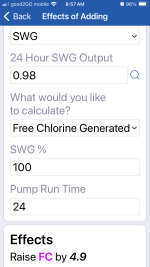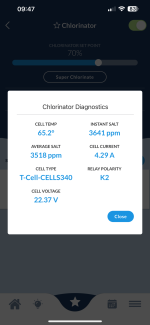- Dec 8, 2023
- 57
- Pool Size
- 24000
- Surface
- Vinyl
- Chlorine
- Salt Water Generator
- SWG Type
- Hayward Aqua Rite (T-15)
I have been doing a lot of reading while I am waiting for my test kit to arrive(which arrives today). I want to make sure I understand that if I need to get my FC level up (balancing it with CYA), the best way is to add liquid chlorine. Having a SWG does not preclude or relieve me of having to occasionally add liquid chlorine, the SWG simply can make me need less because it’s generating some chlorine. Am I correct?



